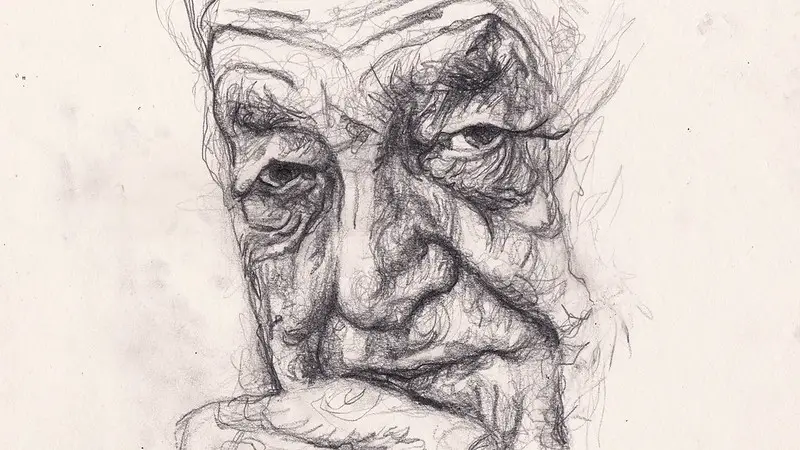If two people are smitten with each other, people usually attribute it to the chemistry between them. There was certainly high chemistry between Mimi Blayney and Don Galvin when they met each other in 1937, at a swimming competition. Galvin asked Blayner directly whether she’d date him, and they remained as lowers until Galvin passed away in 2003.
However, apart from highly active teenage hormones, there was also a different thing between them. Had both of them fallen in love with different people, their kids could have been people fitting society and who don’t have many exceptional qualities than others. However, Don and Mimi’s genes cam together in a fashion beyond conventional. Their exceptional genetic convergence resulted in kids who have an inclination toward schizophrenia, which indicates that whatever emotional or physical trauma they experience would make the kids much closer to worsening mental illness.
Mimi gave birth to 12 kids, and each experienced abuse in some mode. At a minimum, three of them went through sexual abuse, some were exposed to this by their own brothers and sisters. Other kids were neglected by their father and mother, virtually unavoidable in a big family like theirs. Each of them lived through violence in their house. Moreover, each suffered from schizophrenia or had to witness the tragic experience of seeing their siblings no longer able to separate what is real and what is imaginary. Finally, physicians said six of the kids suffered from schizophrenia. The rest continues to cope with the disaster they witnessed as kids on Hidden Valley Road: a funhouse representation of the American dream. One researcher claims they are the most psychologically sick family in America.

Chapter 1 – Blayney accepted to get pregnant many times so as to divert her attention from her numerous disappointments.
During the first years of her marriage, it was a lot different than her exciting romance with visionary, dark-haired Galvin. Following the quick wedding in Tijuana in 1944, Blayney used to make jokes about Galvin merely being at home sufficiently long in order to impregnate Blayney again.
Until they relocated to Colorado Springs as Don had a novel job there, Blayney had delivered three boys, and Don had been having a relationship with another person, which was his first affair out of at a minimum six affairs. The marriage was a disappointment for Mimi. Mimi had relocated from her home to new places across the country, going after wherever Don goes; at that moment, she was beset with the feeling of abandonment. Don desired a large family; thus, thinking that she could get him home, Mimi accepted to get pregnant many times.
The kids provided her with happiness. The kids allowed her to act the role of “good mother,” even though Don wasn’t home.

Don and Mimi bought a huge novel home on Hidden Valley Road. However, it had no effect on the distance growing between them. Don didn’t give away much information regarding his life to Mimi. Yet, Mimi went on to make efforts to render him contented. She agreed to get baptized and be Catholicism for him, which she pledged to do prior to their marriage. Mimi became more acquainted with the priest in Colorado Springs in their neighborhood. The priest and Mimi would read scripture over cocktails, and the priest started to know Mimi’s increasing quantity of sons, as well. Until 1957, she had delivered eight sons. All of her children slept in the same room, in two bunks that had four beds in the basement.
The first of the sons, Donald Jr., became a shining high school football. Donald Jr. was debonairly good-looking, was dark-haired, and had glowing eyes, the same as Don himself. However, he wasn’t as smart or charismatic as Don Sr. Worse, he was inclined to violence. He used to compel his brothers to bring them to blows to each other. Together with Jim, born after Donald Jr., they used to fight each other vehemently everywhere in the house.
The couple ascribed their fights to boys being boys. However, it wasn’t as simple as that. Even Donald Jr. was aware he wasn’t interacting with the world in a normal manner. This indicated the earliest warning of his inevitable diagnosis: schizophrenia.
This wasn’t the only reason for Donald Jr.’s anguish. There was another reason that wouldn’t come to the surface until a few decades later.
The priest, Father Freudenstein, had molested him for many years, as he had done to many other boys in Colorado Springs. Finally, physicians would say Donald’s psychotic break was the reason for abuse, which was the instance of a plethora of family trauma.
Chapter 2 – While the couple was climbing the social ladder, their children’s psychological well-being started to worsen.
Jim, the one born after Donald Jr., was as strong or handsome as Donald Jr.; thus, he assumed a James Dean image, replete with a leather jacket and sneer. Both Donald and Jim hated each other, and the sole thing they coped with it was using violence. The others found themselves as being part of this violence. Each day, they would come to blows in the backyard and while they were going to and coming from school.
Don developed the habit of assigning numbers to and calling his children with those numbers, rather than their proper names. For example, when Don utters “Number Four, come here,” he refers to his son Brian. The children usually thought they weren’t getting enough attention as there were many of them, and seldom felt secure.
The couple decided to perceive what was going on as simply boys being boys. Their calendar was full of social gatherings as Don’s novel position as executive director of a lobbying group concentrating on supporting the arts. Don and Mimi participated in parties in Aspen and Santa Fe, coming into contact with people like Andrew Wyeth and Georgia O’Keeffe. Mimi felt happy at the time, as she never had felt so for many years. Accepting something was going amiss in their house could have jeopardized their growing eminence in Coloradan society.
However, there was something askew at home, and this thing was just started to become more noticeable. After Donald Jr. enrolled in university, he started losing more and more his grip on reality. He opened out to a school counselor that he was putting some animals to death, and he was imagining murdering people, as well. After his parents took him back from university, Donald Jr. was cleaning his hair using beer instead of water. However, rather than finding help for him, Don and Mimi received a physician’s note from a friend of theirs, stating Donald Jr. had no psychiatric problems. The university readmitted him.

Jim enrolled in the university as well and continued his education for a year or so. After his girlfriend Kathy learned she was pregnant, Jim and Kathy decided to marry, and Jim left the university and started working as a bartender. From the onset, there was chaos in the marriage: aside from having an affair with someone else, Jim also abused her. Kathy thought about abandoning him, however, she felt sad for Jim. He had started being afflicted by voices. Jim stayed in hospital shortly for a psychotic break, which was the first of such breaks and it happened on Halloween 1969.
After explaining to the Galvin parents the event, Kathy thought she would see tears. Rather, she saw no reaction. Don and Mimi looked as if their son’s having such a break wasn’t something extraordinary. the Galvins hid from Kathy that Donald Jr.’s actions were odd as well.
Chapter 3 – Back then, getting professional help for psychological disorders was a terrible idea.
As people living in the 21st century, Don and Mimi might appear as very cruel parents. How come could they have normalized their sons feeling insecure? Or put their social eminence before their sons’ well-being?
Mimi acknowledges not being the ideal mother. However, they were thinking positively, as would anyone who has 12 kids would do. Initially, she wished things would start to normalize if their sons were living their own lives. Later, Mimi saw her two eldest sons had to receive help. However, they couldn’t find enough help.
From England’s King Henry VI’s accession to the throne upon his grandfather’s madness and starting the fifteenth-century Wars of the Roses onward, people have realized that psychological disorders can be passed down to other generations. However, Freud challenged this traditional wisdom: Did people come to the world with schizophrenia, or suffer from it during their lifetime?
The psychotherapist Frieda Fromm-Reichmann improved Freud’s theory a bit more. In 1940, she started making her theory known, which was about neglectful mothers being the reason for the psychological disorder. During the years when the role of motherhood was transforming, this theory became popular. In the 50s and 60s, virtually all emotional or psychological issues were thought to have followed from the patient’s mother. The same thing happened even in Hollywood: in Alfred Hitchcock’s famous movie Psycho, shot in 1960, the responsibility of Norman Bates’s self-destructive delusions is attributed completely to his mother.
Furthermore, the therapies for psychological disorders back then were usually more frightening than the symptoms. People who suffered from Schizophrenia were placed at impersonal institutions, occasionally for many years back then, and compelled to use such things as cocaine and castor oil. Those patients were killed with carbon dioxide, shocked with insulin, given turpentine and animal blood through their veins; their brains were taken out. Occasionally, those patients were emasculated without giving any permission.

Thus, after Donald Jr. and Jim began falling in the grip of Scziophrenia, Mimi found herself in an impossible position. The psychiatrists would attribute the whole responsibility for everything to her. Even though she could endure the sexist monitoring, her sons that she loves most dearly would have to experience a treatment process that would arguably make the disease look like an angel.
What they had to do in those times was obvious: When your kids suffer from psychological diseases, explaining the situation to a psychiatrist was definitely the final alternative.
Chapter 4 – When Donald Jr. had to go to the hospital after his psychotic break, it aggravated the petrifying violence on Hidden Valley Road.
Since Donald Jr. was readmitted to the university, everything like going well for some time. He started participating in lectures, and he even began going out with a student called Jean. When they started sharing a house, the relationship soon worsened. In one of their fight, Donald Jr. warned Jean that he’d drown her. She explained to him, without any doubt on her mind, that she’ll no longer continue this relationship. This caused Donald’s earliest huge psychotic break.
After several days, he returned to the house carrying two cyanide tablets and attempted to compel Jean to swallow one of them and he would swallow the other. She managed to escape, and the police detained Donald Jr. There was no option before Don and Mimi: Donald Jr. was warehoused in a state in-patient mental hospital, in Pueblo.
The care service at Pueblo was dreadful. The personnel didn’t consist of people who graduated from nursing, and there were no more than just a few physicians treating more than 2,000 people. The mental hospital had the authority to give Thorazine to patients, which was a medication created as a battleground anesthetic following World War II and wasn’t tested. After being taken some drugs there, he was considered poised for discharge. Donald Jr. returned home merely several weeks later.

Donald Jr.’s arrival brought more trouble for the Galvin family. Margaret and Mary, the youngest of the Galvin family, were eight- and seven-year-old, respectively. Almost whenever they arrived home from school, the girls would see Donald Jr. completely naked and raging. The violence went on, as well: Donald Jr. continually threatened Mimi with a knife. His other brothers would need to take him down and hold him still.
Day by day, it was getting more frightening for Margaret and Mary. Their eldest brothers would play harshly with them, throwing them around as if they were toys. When the girls got bigger, their brothers also started arguably physical abuse.
Very interestingly, their mother continued to outwardly disregard these events. Rather, Mimi became more resolute on her perfectionism. Margaret and Mary were anticipated to prepare the table and clean the dishes when the dinner was over as if an adult in the house weren’t squirming on the floor.
Donald Jr.’s other brothers savagely joked about him. Jim was particularly cruel, ridiculing Donald Jr. for still being at their parents’ home as an adult. However, Jim enjoyed the chance to defend his siblings from Donald Jr. as well. Jim and Kathy told Margaret and Mary that they could drop by their home whenever they wanted, occasionally for whole weekends. Mimi felt thankful for the short period of rest.
Jim was affectionate and greeting to his sisters. However, he started abusing them sexually.
Chapter 5 – While the Galvin kids continued to become adults, all of then searched for how to cope with the imminent ghost of the psychological disease.
Jim molested Margaret and Mary for years, which began when Margaret was five. However, what they thought as normal was so distorted that the abuse didn’t seem like violence in their eyes. It was a way of showing love for them.
The girls noticed first that Jim also had the same instability as Donald Jr. Apart from the sexual abuse, they noticed that he was consuming alcohol, that he also physically abused Kathy.
Yet, the girls continued to tolerate Jim, since they were able to somewhat find peace from Hidden Valley Road; so, it was okay.
But one other factor that made them regard sexual abuse as normal existed. They were abused by their other brothers, too. One of Mary’s first recollections is of Brian abusing her sexually at the age of three.
Their traumatic first recollections of Brian were incompatible with what they witnessed outside. Brian was the most admired child of the Galvin, the most attractive and smartest, athletic and played instruments, and was the most favorite of Don and Mimi. They admired Brian even when he left the university education, began using drugs, and relocated to California in order to set up a music group.
Michael, the fifth of the children, didn’t even try to enroll in the university. He traveled around the country collecting mushrooms. Following several arrests, the court decided to imprison him for five months in a maximum-security mental ward. However, Michael had no problems as his brothers did. Michael was nothing but a hippie who had problems with authority. Throughout his life, Michael would strive to demonstrate he was mentally fine.

The sixth child, Richard, was a great hockey player. When he was seventeen, after making the goal that brought the state championship, he impregnated a girl. Richard and the girl chose to marry. Richard consumed mushrooms and was high at the time of the wedding. Donald Jr. intervened in the wedding by yelling that the marriage was fake.
The third eldest son, John, played piano almost throughout his youth and eschewing his elder brothers. After being offered a scholarship for his music studies at college, he seldom returned to Hidden Valley Road.
He returned home once and everything was much more terrible than when he was there: Donald Jr. fluctuated uncontrollably between raving and violence. Mimi had prepared some lines to read aloud, which were intended to use against Donald Jr.’s common rants. She boasted about her society gatherings, pretending as if everything were okay.
The situation was terrible. However, it was going to be more appalling.
Chapter 6 – When Brian attempted to kill others and then commit suicide, the Galvins reached a very low level, however, the Galvins hadn’t fully plunged into the abyss yet.
Mimi had acquired a talent for hiding negative developments. Receiving phone calls from the police and the mental ward, and news about suspensions from school or teen pregnancies weren’t new for Mimi.
However, she wasn’t ready for the call that happened one morning in late July or August 1973. The girl their favorite son Brian dated didn’t come to the work. After the police arrived at their house control if something was wrong, the police saw she was dead.
There was another person at home, though. After having murdered her girlfriend by shooting in the face, Brian wielded the weapon on himself.
When asked by other women in society, Mimi responded that she lost her son in a bicycle accident. When asked by friends, she replied by saying that she lost him in a botched robbery. No one but herself and Don was cognizant of what really happened for years: Doctors had said several years ago that Brian was suffering from psychosis.
Throughout many years, Don tried anything he could so as to stay away from his family that lost control. Don started joining in night classes, became the cocktail shaker at gatherings, and went on his life with affairs.
However, the thing Brian did was something unendurable, and he made the pain something natural. In 1975, he had a huge stroke immediately before his youngest boy, Peter. Don stayed in the hospital for twenty-four weeks, and could never completely recuperate. He became reliant on Mimi for the remainder of his life.

Peter never became as he used to be, too. He experienced his earliest psychotic break immediately upon seeing his father’s collapse. He was no older than fifteen-year-old at the time.
The Galvin family was starting to be popular among the personnel at Pueblo, the state mental institution. Apparently unexpectedly, Matt, the second youngest of the boys, had started calling himself Paul McCartney. Matt, Peter, and Donald Jr. were at this moment entering and leaving Pueblo as if in a vicious cycle. When the Galvins were coming to see their sons, the hospital personnel were able to notice Joe, the seventh son, had also some problems.
In a seldom demonstration of weakness, Mimi began to cry while she was on line talking to a society friend. “Margaret and Mary must get out of that place,” her friend told her. “Margaret can stay at us, send her over.” Mimi did what her friend said to her.
Thus, Mary, at the age of 13 at the time, became the sole kid at home who didn’t go through psychosis. In order to save herself from that house, Mary applied and was admitted into a boarding school on the East Coast.
Being aware he would no longer be able to get in touch with Mary, Jim increased his abuse. Prior to the summer when Margaret left home for her novel school, Jim raped her.
Chapter 7 – There was no kid remaining at home, much of the harm had been already done. However, things would continue to go as terrible as they were for a while before they returned normal.
The Galvins’ self-examining seventh son, Joe, became the last to experience a psychotic break. Joe first experienced psychotic decompensation after he couldn’t get a promotion at his workplace. With Joe joining them, four Galvin brothers found themselves in almost the same wheel. Their lives passed between Pueblo, the street, and their home on Hidden Valley Road. Occasionally, they were incarcerated.
Jim didn’t end up entering and leaving Pueblo as often as his brothers. However, he became at the time the sibling all family was most concerned about. Her wife had eventually abandoned him when he punched their child Jimmy. Jim started living single, working less, and consuming more alcohol. Once, Mary brought his boyfriend to the Hidden Valley Road from university, Jim cut his cars’ wheels and yelled indecent words.
The wholesome Gavin kids were influenced by what they went through, and they were worried that they could be the next person to go insane. Thus, they made sure they were as far away from their home as they could.
All siblings were seeking their own stories. Mary adopted the name Lindsay so as to have something that belonged to herself and not to the Gavin family. Margaret left university in order to accompany the Grateful Dead across the US; she took cocaine and mushrooms and stayed married to a drug trafficker for a year. The four wholesome brothers didn’t call their home a lot and go there less. Don’s well-was still declining since he was sitting in the house every day, thinking about how his life became upside down.

At the same time, Donald Jr. started trendsetting for the Gavins again. About forty-year-old at that time, he had no longer been acting as violently before and much of his violence disappeared. The years of schizophrenia treatment had caused damage to him, which also happened to his other ill-stricken brothers. He became too much overweight and had a vulnerable heart and tremors. Had it not been for all the damage, the treatment wouldn’t have been as useful. Donald Jr. started thinking his actual father was an octopus.
Nevertheless, Lindsay was making headway on her quest to settle accounts with her abuse and get healthy again. At the university, she began going to a therapist to cope with her worsening anxiety. The first therapist she went to directly assumed her story about having six older brothers who suffer from schizophrenia was inaccurate. However, after eventually finding a good therapist, Mary could start disclosing her years of trauma. It was a process that would continue for more than two decades.
Chapter 8 – The large Galvin family is a perfect genetic specimen group for schizophrenia researchers to assist future generations.
Many years after Donald Jr. had his first psychotic break, internal conflict within psychiatry emerged. Not being able to discover tangible evidence for the reason behind schizophrenia, the field was divided into two different approaches: nature vs. nurture. There were lots of theories, however, science could neither discover a treatment that functioned nor a cure.
However, this doesn’t indicate that researchers weren’t studying to find treatment. Dr. Lynn DeLisi, a psychiatric geneticist, thought the origins of the illness were physical. Throughout her professional life, she tried locating a genetic marker of the illness.
Dr. Robert Freedman, in contrast, tried understanding the way the illness worked. What was going on in the brain to lead to worsening behavioral symptoms like these?
However, one thing was occupying both DeLisi and Freedman’s minds: what is the reason for one family to be struck so hard with the disease?
The first time when Lynn DeLisi talked with the family was in 1990. Mimi became extremely happy as she’d been expecting for many long years for a physician like her to come, a physician who could help her lingering painful feeling that everything could be her responsibility. DeLisi gathered genetic specimens from all of the Gavins. She planned to make a comparison of the Galvin DNA to see which gene caused schizophrenia.
After DeLisi mentioned Freedman about the unusual Galvin family, it also drew his attention. Freedman asked the Galvin family to come to his laboratory. Freedman wanted to examine them to determine the particular section of the brain causing schizophrenia symptoms.
The scientists were expecting that their examinations would result in a medication that would help cure schizophrenia or even provide a means to foretell who might suffer from it. Not being able to find anything after several frustrating examinations, the scientists discovered genes that they thought are linked to schizophrenia.
It is not as simple as merely one gene, however. Scientists today mostly in accord that though people who suffer from schizophrenia have the same gene mutations, environmental factors – generally childhood trauma – are the things that make someone go beyond the schizophrenia threshold.

Thanks to the Galvin family, scientists could make these findings. However, even now, a medication that assists to mitigate psychosis sufficiently to make up for the side effects won’t be produced shortly. DeLisi’s and Freedman’s findings were too delayed to assist the Galvins. Jim and Joe passed away due to complications from weak hearts, the reason of which was the years of schizophrenia medications. The medications had ameliorated their situation only incrementally. The other brothers who suffer from schizophrenia continue to take these drugs. There is nothing else they can do.
Chapter 9 – Via therapy, Lindsay managed to settle accounts with her family’s history – and lead the way forward.
With Mimi getting more aged, Lindsay started undertaking more duty for her family’s well-being. She had taken many years of therapy, which made it possible for her to settle accounts with her trauma sufficiently to connect with the unusual reality of her family.
Lindsay talked to Mimi about Jim’s sexual abuses that lasted for years as well. Without pausing, Mimi disclosed that, when she was a small girl, her stepfather sexually abused her, too. Lindsay was surprised by Mimi’s honesty. However, Mimi couldn’t convince herself to accept that the action of Jim was immoral. It upset Lindsay but she was resolute: she explained to her mother that she could never stay in the same room where Jim was. She stuck to her words for the remainder of the time Jim lived.
Lindsay also assumed the legal guardianship for her sibling Peter. She believed she could be more successful in handling his care. Peter began living with her, and he appeared to be getting better. While living together, she discovered that Jim abused Peter as well when they were kids.
However, after Peter ceased taking his drugs, his intense psychosis relapsed more acute than before. Lindsay, now married and with two children, could no longer bear it. The most suitable place for Peter was the state mental hospital in Pueblo, which was suggested to her by Freedman.
After Mimi passed away at the age of 90, Lindsay managed her end-of-life care and had their home on Hidden Valley Road sold. She looked at medical records and for the first time found out Donald had attempted to murder his girlfriend Jean, many years before. It was shocking for her to see how discreet Don and Mimi were. How would things turn out to be had her parents been more candid about what was going on? Would it be possible to forestall what Brian did to her girlfriend and himself?

While looking at medical records, Lindsay’s investigation wasn’t just limited to searching simply for closure. She wanted to foretell what would expect her own kids – Jack and Kate. Beginning from when they were very young, Lindsay was mindful of any symptoms of the disease in her children.
Kate and Jake are fine today. Lindsay’s girl Kate today is employed at Dr. Freedman’s university lab, where her grandfather’s brain and DNA specimens from many of her numerous family members are located. She became the first undergraduate to get a position in the lab; thus, her first day generated much bustle. One student made a joke, saying that her family must have been huge donors. Kate was already prepared with a comeback: “do you mean money or tissues?”
Hidden Valley Road: Inside the Mind of an American Family by Robert Kolker Book Review
The account of the Galvin family is a private, tragic window into our very limited knowledge about schizophrenia. However, by means of DNA sampling and brain examination, the Galvins’ sad history may still provide us with insight into how to cure, foretell, and even stop this worsening illness for future generations.
